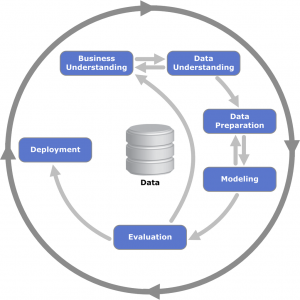
PT Survey Prima Solusi Statindo (Purple Analytics) adheres to a universally accepted standard of Data Mining called CRISP-DM (Cross Industry Standard Process for Data Mining). As can be seen in the figure below, there are 6 very important phases in every analytic project:
 BUSINESS UNDERSTANDING
BUSINESS UNDERSTANDING
This initial phase focuses on understanding the project objectives and requirements from a business perspective, then converting this knowledge into a data mining problem definition and a preliminary plan designed to achieve the objectives.
DATA UNDERSTANDING
The data understanding phase starts with initial data collection and proceeds with activities that enable our team and Client to become familiar with the data, identify data quality problems, discover first insights into the data, and/or detect interesting subsets to form hypotheses regarding hidden information.
DATA PREPARATION
The data preparation phase covers all activities needed to construct the final dataset [data that will be fed into the modeling tool(s)] from the initial raw data. Data preparation tasks are likely to be performed multiple times and not in any prescribed order. Tasks include table, record, and attribute selection, as well as transformation and cleaning of data for modeling tools.
MODELING
In this phase, various modeling techniques are selected and applied, and their parameters are calibrated to optimal values. Typically, there are several techniques for the same data mining problem type. Some techniques have specific requirements on the form of data. Therefore, going back to the data preparation phase is often necessary.
EVALUATION
At this stage in the project, we would have built the models that appear to have high quality from a data analysis perspective. Before proceeding to final deployment of the model, it is important to thoroughly evaluate it and review the steps executed to create it, to be certain the model properly achieves the business objectives. A key objective is to determine if there is some important business issue that has not been sufficiently considered. At the end of this phase, a decision on the use of the data mining results should be reached.
DEPLOYMENT
Creation of the model is generally not the end of the project. Even if the purpose of the model is to increase knowledge of the data, the knowledge gained will need to be organized and presented in a way that the customer can use it. It often involves applying “live” models within an organization’s decision making processes-for example, real-time personalization of Web pages or repeated scoring of marketing databases. Depending on the requirements, the deployment phase can be as simple as generating a report or as complex as implementing a repeatable data mining process across the enterprise. In many cases, it is the customers’ front line, not the data analyst, who carries out the deployment steps. However, even if the analyst will carry out the deployment effort, it is important for the customer to understand up front what actions need to be carried out in order to actually make use of the created models.

 Telp. 021.750-2313
Telp. 021.750-2313  Yahoo Messenger :
Yahoo Messenger :